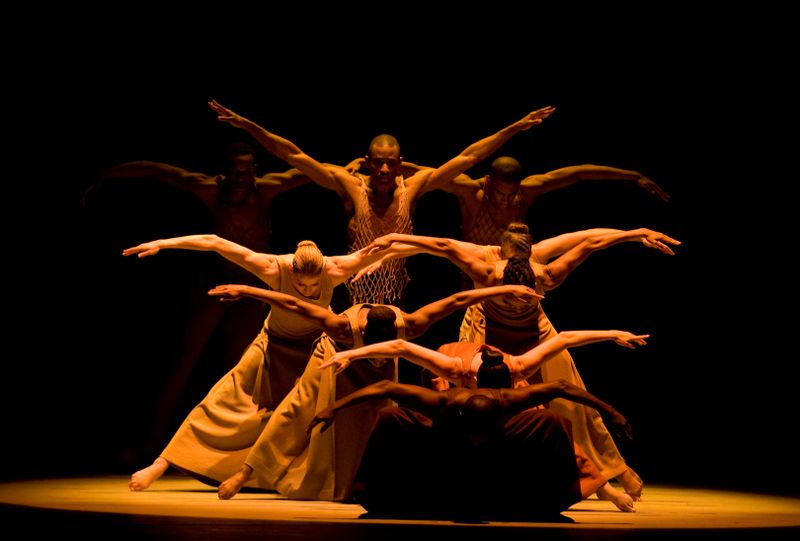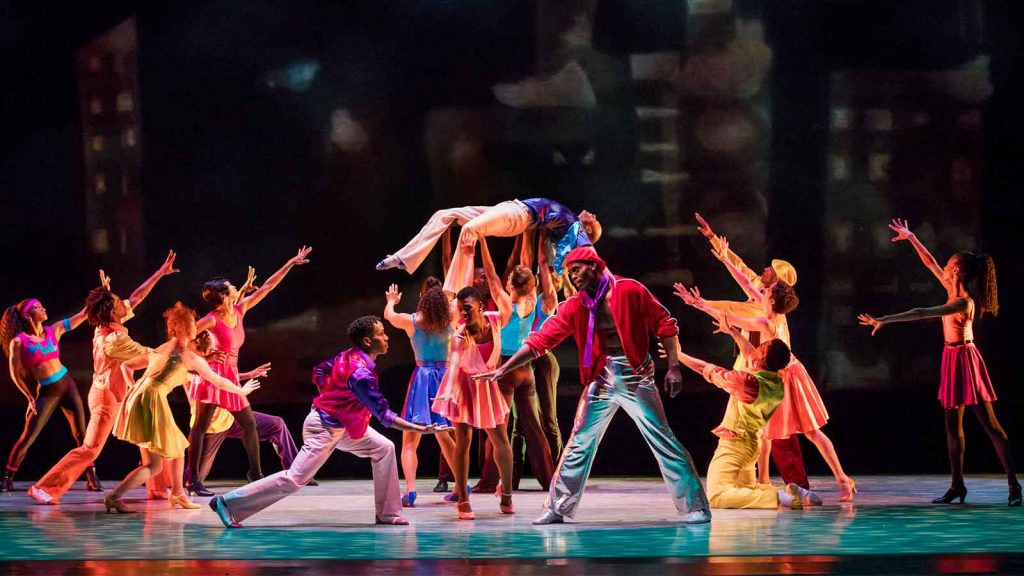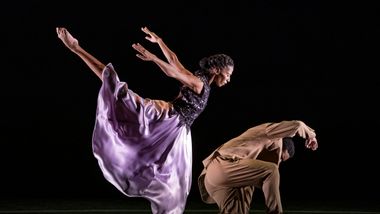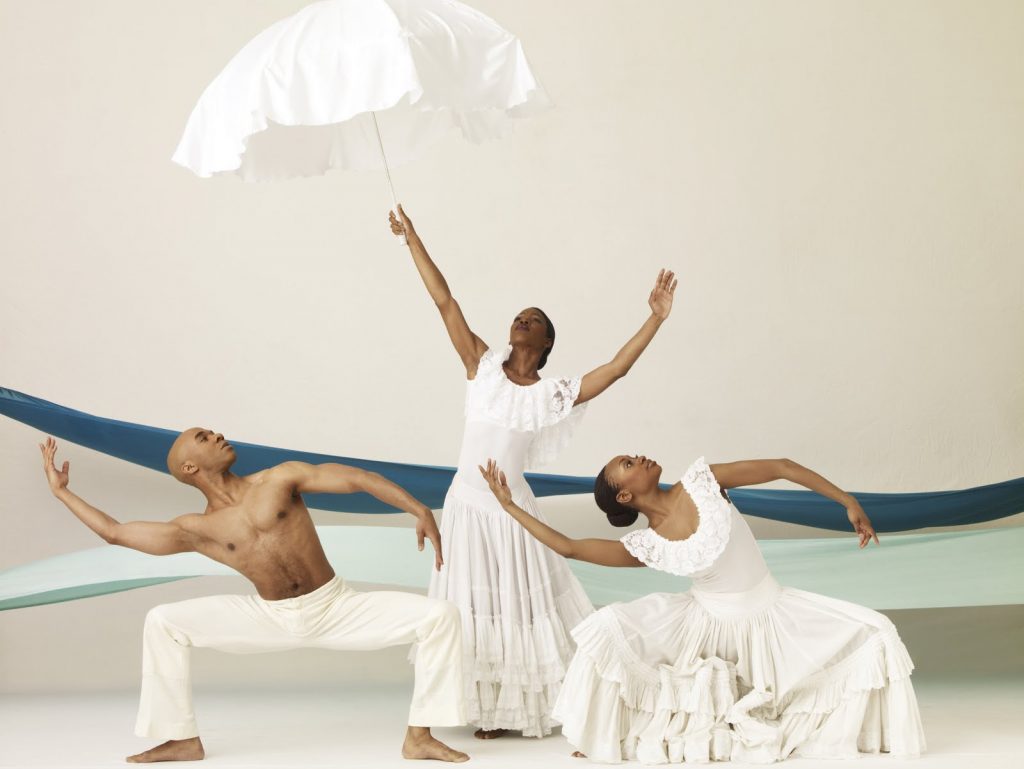Alvin Ailey American Dance Theater Delivers Stunning Artistry and Message of Hope
The LA-Horton connection. The Broadway and jazz experience. The frenetic Russian leaps followed by salvation and joy. Celebrating the company’s 60th anniversary, Alvin Ailey American Dance Theater performed two mixed-repertory programs at Copley Symphony Hall on March 26 and 27. This is an unforgettable living tribute. The stunning artistry speaks to the past, and offers a message of hope for the future.

Alvin Ailey American Dance Theater in “Revelations.” Image Nan Melville
Both programs ended with Ailey’s Revelations, which has a rousing encore that lingers. Tuesday’s program of five dances opened with a pulsing beat.
Stack-Up conjured the brutal streets of old Los Angeles, or perhaps another dimension where disco meets Soul Train. Choreographer Talley Beattey (1918-95), a Chicago native, toured with the Katherine Dunham Company and appeared on Broadway, and his physically demanding work fits well in the Ailey repertoire.

AAADT in Talley Beatty’s “Stack-Up.” Image: Paul Kolnik
Set against a cityscape painting by Romare Bearden, dancers dazzle with breathtaking cartwheels, jazzercise, and bursts of disco. This story ballet about a romantic couple and a lonely drug dealer was created in 1982, and still hits home as a social commentary. Costumes by Carol Vollet Kingston are fascinating mixes of neon that make it wonderfully dated, yet provocative.
It’s not easy to preserve the past and appeal to a 21st century audience at the same time. The heirs of Alvin Ailey’s legacy continue to find balance with commissioned new works. This program was a healing tribute to a dance icon with an unlikely start.
Born in Texas in 1931, Ailey attended the local Baptist church where Holy Rollers made a big impression. In 1942, his mother moved to Los Angeles to work at a Lockheed aircraft factory. Ailey was athletic and went to UCLA to study languages. Everything changed in 1949 when he took modern dance classes taught by Lester Horton. Horton was an authority on Native American dance, as well as African and Asian styles, and created dance for concert stage and musicals.
Ailey joined Horton’s company the following year, but a few months later Horton died of a heart attack. So Ailey began to choreograph and design sets and costumes.
He later studied in New York at the Graham school, and appeared in shows on and off Broadway. In 1958, he assembled a group of seven dancers, and Alvin Ailey American Dance Theater went on to tour the world like rock stars. Ailey died of AIDS in 1989, but his company continues his mission to bring compelling dance to everyone.

AAADT dancers in “The Call,” choreographed by Ronald K. Brown. Image: Paul Kolnik
In The Call, choreographed by Ronald K. Brown in 2018, dancers interpret Bach and cool jazz, and conjure the spirits of dance legends and African ancestors. In the opening scene, a woman dressed in satin and black lace dances with a man in wide-trousers.
Historians may imagine Ailey dancing with his friend and partner Carmen de Lavallade, turning with sharp elbows to the pizzicato of a violin. But suddenly we flashback to a slaves in a field. There is another shift to bluesy piano and we picture four dancers in a night club. They don’t have tap shoes, but seem to tap in silence. The final shift sends us from arabesques to contractions and undulating hips. The piece finds resolution as the syncopation grows and the dancers change direction. Final images of them pressing their hands to their hearts is breathtaking.
The company presented two works by Robert Battle, Ella and Juba. Battle is artistic director, only the third to head the company since its inception in 1958.
Ella, from 2008, was an Ailey premiere in 2016 that has become a hit, because of the daring concept of dancing to Ella Fitzgerald’s insanely fast scat singing. The genius of Mr. Battle is having dancers twist and jump with absolute precision to a score that is chaotic. The Alvin Ailey dancers become the notes, rising and slamming, running and spinning to the jazz singer’s recording of “Airmail Special.” Listen to her impossible “de-de-do-dahs” and try to imagine the hilarious rehearsals. How did they learn this?
Mr Battle’s Juba from 2003 is fueled by an original score by John Mackey. Electric and ritualistic, dancers fall to the ground and jerk as if possessed. It’s been compared to “Rite of Spring,” but happier. Their unbridled energy and athletic new forms are disturbing and infectious. And when they become Russian Cossacks dancing a high-kicking jig, we don’t want them to stop.
Both programs ended with Revelations, Ailey’s masterpiece from 1960, inspired by his childhood and black experience. We see the influence of Horton, and Ailey’s gift for using props and creating tension.
Deceptively simple and brilliantly constructed, Revelations uses the power of African-American spirituals, gospel songs, and holy blues to explore intense grief and joy.
There are three sections designed to stir an audience, starting with “Deliverance.” It opens with nine dancers in drab brown costumes swaying and reaching their arms upward and downward opening like a flower.

Alvin Ailey dancers in Revelations. Image: Andrew Eccles
The processional “Take Me to the Water” has rippling blue and white fabric stretched across the stage, like a shimmering river, and women parade with icy white parasols. In “Sinner Man,” three men try to escape a voice singing “where will you run to?” The tension grows in the emotional duet “Fix Me Jesus,” as a woman falls into the arms of her attentive partner. Strong and delicate, the final scene has her balancing in arabesque on the man’s thigh. It’s as if he helps her to fly.
We wipe away tears and regain composure when women dressed in canary yellow dresses and floppy hats fan themselves and balance on stools. It ends with a snappy ensemble of men and women and strutting their happy feet in “Rocka My Soul in the Bosom of Abraham.” By the bows, we are so filled with joy, we could burst. And then there is an encore. The finale experience is Ailey’s gift, often described as a state of grace.
Alvin Ailey American Dance Theater was presented by La Jolla Music Society, as part of the Dance Series.

Excellent review.
As always a magnificent dance review!